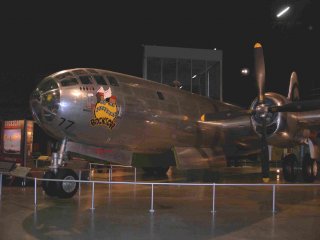Where Can You See a B-25, Air Force One and the B-29 That Bombed Nagasaki?
It is the oldest and largest military aviation museum in the world, with more than 360 aircraft and missiles on display—and while it may lack any beaches, the museum still draws in about a million visitors annually, making it one of the most frequently visited tourist attractions in the entire Midwest.
During the annual spring break season, many college students may opt to head to Daytona Beach, but throughout the year aviation history buffs may want to make the trek instead to the central Ohio city of Dayton. The sixth-largest city in the Buckeye State is home to Wright-Patter Air Force Base, where aircraft operations take place on land that is now part of the military facility but was first used by Wilbur and Orville Wright in 1904.
Following the First World War, captured German aircraft were brought to the field and incorporated into a small Army museum dedicated to aviation. Some of those planes are still in the collection, which has continued to grow over the years to make what is today the National Museum of the United States Air Force. It is the oldest and largest military aviation museum in the world, with more than 360 aircraft and missiles on display—and while it may lack any beaches, the museum still draws in about a million visitors annually, making it one of the most frequently visited tourist attractions in the entire Midwest.
Its exhibits are spread out over 1,120,000 square feet in four massive aircraft hangers that are divided into a dozen galleries, which explore the history of military aviation from the early 20th century, through both World Wars and into the modern era. In addition to the expected focus on military warbirds, the museum is also home to numerous research and development (R&D) aircraft as well as numerous planes used by former presidents of the United States.
A Most Notable Collection
Among those 360 aircraft in the collection are some truly important aircraft—including a Sopwith F.1 Camel, the most successful fighter to fly in the First World War; one of just four Convair B-36 Peacemakers; the only surviving North American XB-70 Valkyrie; and Bockscar, the Boeing B-29 Superfortress that dropped the "Fat Man" atomic bomb on Nagasaki in August 1945. In 2018, the museum also put on permanent public display the restored Boeing B-17F known as the "Memphis Belle."
The history and evolution of aircraft can truly be appreciated throughout each of those four hangers. Within the Eugene W. Kettering Cold War Gallery, named in honor of the first head of the Air Force Museum Foundation Board of Trustees, are such impressive aircraft as a Lockheed U-2A, a Lockheed SR-71A Blackbird and even a Lockheed F-117A Nighthawk. In the Allan & Malcolm Lockheed & Glenn Martin Space Gallery, some of the most notable aircraft spacecraft used by the U.S. military are also on display—from a Fairchild C-119J Flying Boxcar Satellite Catcher to a Hexagon KH-9 reconnaissance satellite.
The William E. Boeing Presidential Gallery includes several aircraft that were used by former Presidents Franklin D. Roosevelt, Harry Truman, and Dwight D. Eisenhower; while the collection also includes SAM 26000, the modified Boeing 707 known as the VC-137C. It was aircraft that carried President John F. Kennedy to Dallas on November 22, 1963, and was where Vice President Lyndon B. Johnson was sworn in as president after Kennedy was assassinated on that terrible day. Nearly a decade later in 1972, the same aircraft was used by former President Richard M. Nixon on his historic "Journey for Peace" visit to the People's Republic of China.
Honoring the Greatest Generation
As might be expected, the National Museum of the United States Air Force pays homage to the Greatest Generation as it is home to a large number of World War II aircraft. In addition to the aforementioned B-17 and B-29, there are countless American as well as British, German, Italian, and Japanese aircraft in the collection including a Supermarine Spitfire that was used by the RAF, a Republic P-17D Thunderbolt, and one of only a handful of surviving German Messerschmitt Me 262A Schwalbes, the first successful combat jet fighter.
It isn't just the aircraft that make up the museum's collection either. The facility helps tale the story of the aviators who flew the aircraft as well. There are dedicated exhibits to the Tuskegee Airman, the first African-American military aviators in the United States Armed Forces; the Women Airforce Service Pilots (WASPs), the civilian women pilots' organization that helped test and ferry U.S. military aircraft during World War II; and notably the American Volunteer Group (AVG)—aka "Flying Tigers"—that was led by Claire Chennault and served in China and Burma to aid the Chinese in the war against Imperial Japan.
Another exhibit is focused on the infamous Doolittle Raiders, the pilots who took part in the top-secret mission to bomb Tokyo on April 18, 1942. While not one of the actual planes used in the Doolittle Raid, the museum has a surviving B-25 that was rebuilt and painted to the configuration of the lead B-25B flown by Lt. Col. Jimmy Doolittle to Tokyo. This aircraft and so many others are just a special reminder of the sacrifices made by those brave men and women who boldly took to the wild blue yonder.
Peter Suciu is a Michigan-based writer who has contributed to more than four dozen magazines, newspapers, and websites. He regularly writes about military small arms and is the author of several books on military headgear including A Gallery of Military Headdress, which is available on Amazon.com.
Image: Reuters

